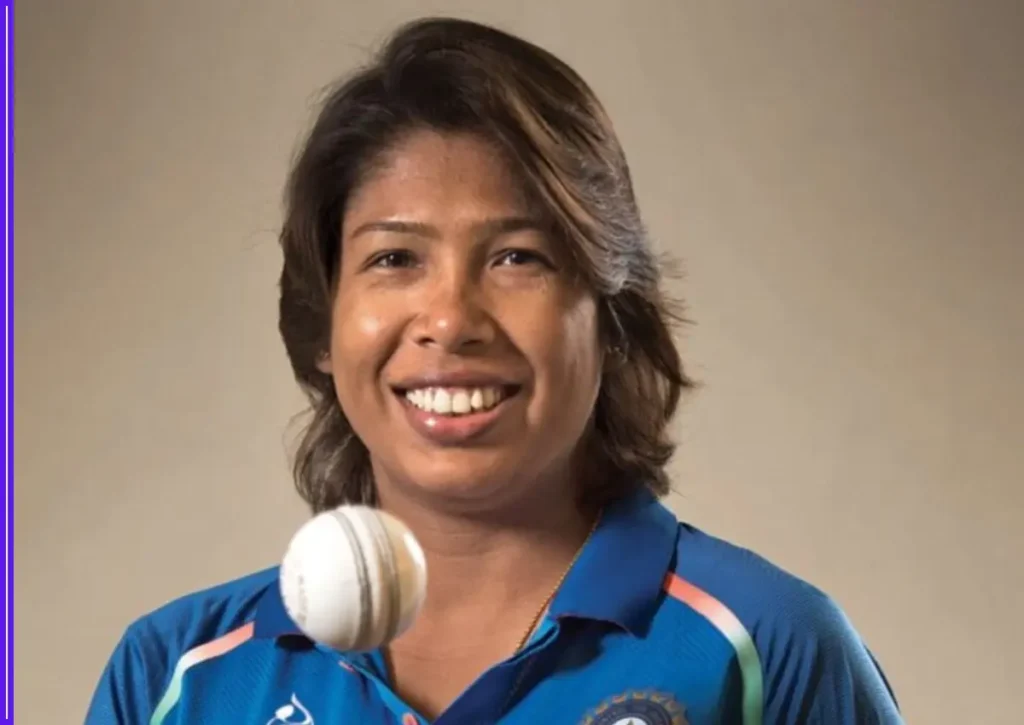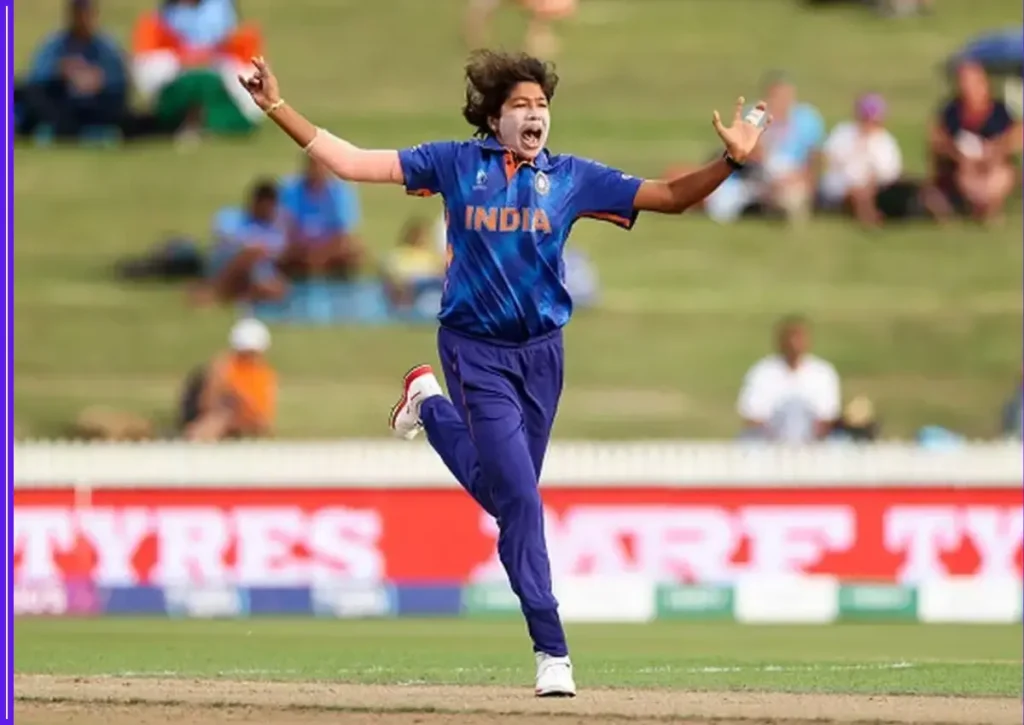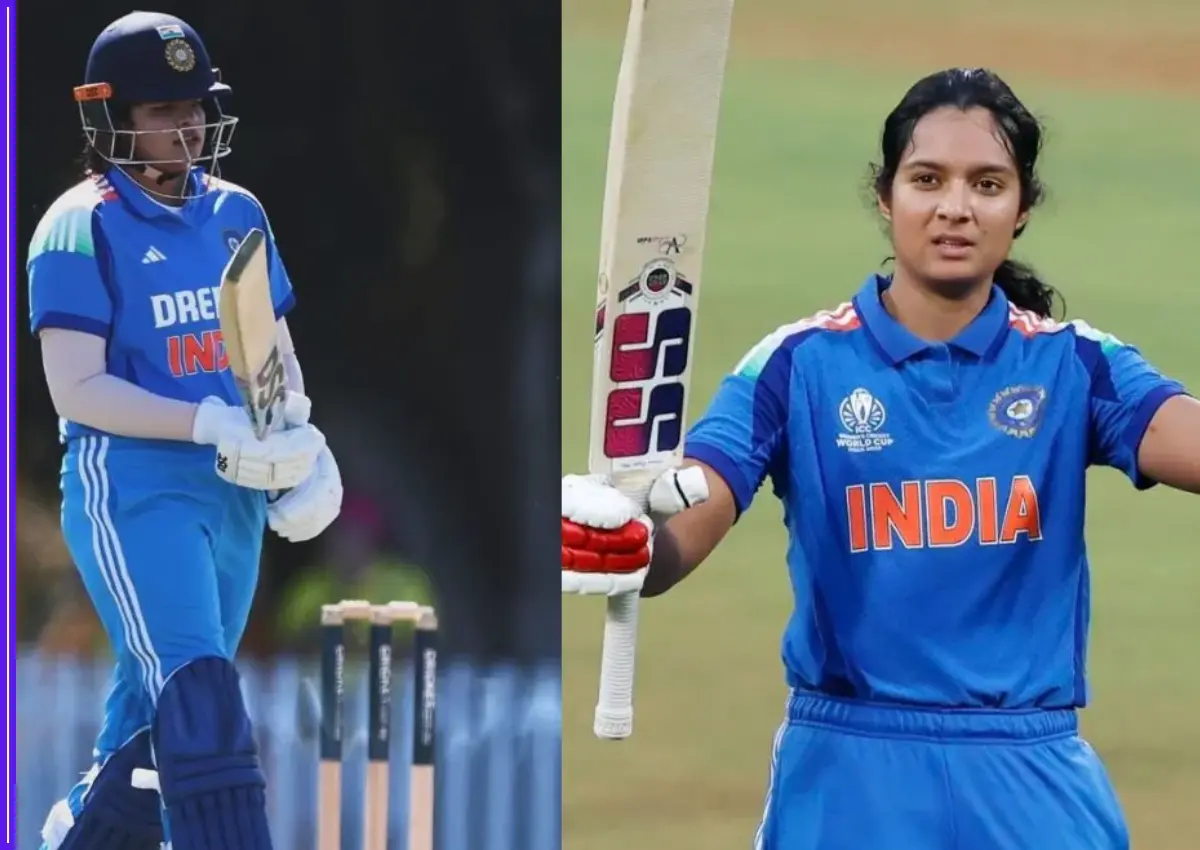Jhulan Goswami stands out more than other names in the world of cricket, which is filled with stories of hardships and victories. Jhulan’s spectacular climb to fame and his journey from the shabby streets of Bengal to the international cricketing stage are nothing short of inspiring. This is the tale of a small-town girl who beat the odds, overcame many obstacles, and emerged as a pioneer in women’s cricket.

Early Life: Growing Up in Chakdaha
Jhulan Goswami was born on November 25, 1982, in Chakdaha, a small town in the Nadia district of West Bengal. Her early childhood was typical of middle-class India, marked by simplicity but also a sense of community. Her father ran a small business, and her mother took care of the household. While many girls of her age were encouraged to pursue traditional paths, Jhulan’s love for sports stood out early on.
Interestingly, football was the first sport that captured her imagination. She played with boys in her locality, running, kicking, and strategizing as if it were second nature. But cricket, the sport that would define her life, entered her world unexpectedly. Watching the 1992 Cricket World Cup on television, young Jhulan was drawn to the elegance and intensity of the game. She found herself dreaming not just of playing, but of excelling at it.
At a time when opportunities for girls in sports were scarce, particularly in smaller towns, Jhulan faced societal skepticism. Many questioned why a girl would pursue a sport dominated by men. Yet, the young Jhulan was undeterred. Her family, while cautious, supported her ambition, understanding that her passion could not be contained.
The First Steps into Cricket
By the age of 15, Jhulan knew she wanted to pursue cricket seriously. However, her town had limited facilities. The journey from aspiration to reality required immense effort. She began playing with boys in her neighborhood, learning the basics of bowling and batting. Her raw pace and athleticism quickly set her apart.
To truly hone her skills, Jhulan began traveling to Kolkata, the nearest hub for advanced cricket training. Daily commutes of more than two hours were physically taxing, but they became a ritual. Under the guidance of coach Swapan Sahu at Vivekananda Park, Jhulan learned not just technique but also discipline, strategy, and mental toughness. Every early morning practice, every evening spent running or refining bowling action, strengthened her resolve.
Despite her determination, balancing school and cricket was a challenge. There were moments when she questioned her path, especially when faced with limited recognition for women in sports. But the fire inside her—the desire to represent her country—kept her moving forward.
Rising Through Domestic Cricket
Jhulan’s first major breakthrough came when she was selected to represent Bengal in domestic cricket. Here, she learned the rigors of competitive play and the mental toughness required to succeed. She faced players with years of experience, but her pace, control, and sheer determination helped her stand out.
By 2002, at just 19 years old, Jhulan Goswami made her One Day International (ODI) debut for India against England in Chennai. Stepping onto the international stage was a dream realized, but it also marked the beginning of new challenges. Playing against seasoned international players required more than raw talent; it demanded adaptability, strategy, and consistent performance.
Her nickname, “Chakdaha Express,” emerged early in her international career, a nod to her hometown and her express pace on the field. This name would soon become legendary, symbolizing not just her speed but her unstoppable rise in the cricketing world..
Challenges and Societal Barriers
Jhulan’s journey was far from smooth. Women’s cricket in India, particularly in the early 2000s, struggled with visibility, funding, and support. The players often had to navigate logistical difficulties, long travels, and limited training facilities. While men’s cricket received national attention and infrastructure, women like Jhulan had to fight for every opportunity.
Moreover, societal expectations were an added challenge. Many questioned whether a woman could dedicate her life to cricket instead of pursuing traditional roles. Jhulan’s resolve, however, only strengthened. She often recounted in interviews how the lack of external validation fueled her desire to prove herself—not just to skeptics but to herself.
Jhulan encountered prejudice towards women and mistrust in a culture where cricket was largely seen as a man’s sport. She defied these preconceived notions, demonstrating that genius recognizes no gender restrictions.
On improvised grounds, Jhulan started his trip with just a borrowed bat and ball. A major obstacle was the lack of adequate facilities and coaching infrastructure. She was unfazed, though, and her ambition to succeed despite her surroundings was propelled by her hunger for the game.

Financial limitations were a powerful foe. Her family’s limited resources made it difficult for them to pay for cricket equipment and coaching costs. She frequently had to pay to attend tournaments and camps, but she never let that get in the way of her zeal.
Jhulan had to deal with a lot of stigmas because of her decisions. Jhulan, a schoolgirl, received jeers for taking the train alone to her cricket practice. This was expressed by her own family members in addition to her other train passengers, which is hardly unusual.
However, it was her grandma who pushed her to continue playing cricket. Her first instructor, Swapan Sadhu, eventually persuaded her parents. Before they became involved, Jhulan had two years to show that she was competent in the field.
Women’s Cricket Legends – featuring profiles of other famous women cricketers.
International Stardom: Breaking Records
Jhulan’s breakthrough on the world stage was inevitable. By 2007, she had established herself as a formidable fast bowler. Her speed, precision, and ability to read the game set her apart from her contemporaries. In 2007, she was honored with the ICC Women’s Cricketer of the Year award, recognizing her exceptional skills and contribution to the sport.
Over the years, Jhulan became the highest wicket-taker in Women’s ODIs, surpassing Australia’s Cathryn Fitzpatrick’s record of 180 wickets. Her consistency over decades is extraordinary; she bowled with pace and accuracy even as newer generations emerged. Each wicket was not just a statistic but a statement of her enduring excellence and leadership on the field.
Jhulan was also known for her performance in World Cups, leading India to competitive positions against powerhouse teams. Her discipline, focus, and tactical awareness made her an invaluable player, both as a bowler and a mentor to younger teammates.
There was no stopping her once she joined the Bengal women’s cricket team. In a 2002 ODI match against England in Chennai, Goswami made her debut for India. After that, she had her test debut. Mithali Raj and Jhulan Goswami led the women’s cricket team to their maiden test series victory in England during the 2006–2007 season.
The youngest person to do so, she took a career-best 10-wicket haul here. She received the ICC Women’s Player of the Year award that year. She held the position of team captain for a brief time from 2008 and 2011.
She was given the Arjuna Award in 2010 and the Padma Shri Award two years later. She firmly kept the top spot when the ICC added a ranking system for women’s cricket as well. She had timed deliveries as high as 120 km/h at the height of her career, making her the quickest bowler in her circuit. She revealed in an interview how the preoccupation with maintaining the top position consumed her and distracted her from the game. And only a legend would admit that.
Inspiring Generations
The women’s cricket squad struggled a lot until recently. The girls were left to fend for themselves without adequate infrastructure. Goswami thought that many more ladies with talent could step forward if given the chance of a lengthy competition like the Women’s-IPL. They can participate in the contest and represent India since, in my opinion, “the more they play, the better they will become.”
Mithali Raj agreed with her sentiments. She recalls their gratitude when 15,000 people showed up to watch the 2017 Women’s World Cup Final. The Indian public first became aware of the women’s team as a result of this defeat in the WWC Final.
They got a lot of help and finally got the attention they deserved. Given that the W-IPL is currently in final negotiations at the BCCI, Goswami’s efforts are not entirely in vain.
Awards, Honors, and Recognition
Jhulan Goswami’s career is studded with accolades:
- Arjuna Award (2010): Recognizing her outstanding contribution to sports in India.
- Padma Shri (2012): One of India’s highest civilian awards, celebrating her achievements and dedication.
- ICC Women’s Cricketer of the Year (2007): Honoring her international impact.
- Highest Wicket-Taker in Women’s ODI History: Cementing her legacy as a record-breaking athlete.
Beyond statistics, these awards reflect her influence on women’s cricket, inspiring countless young girls to take up the sport and dream big.
Retirement and Beyond
After an illustrious career spanning more than two decades, Jhulan retired from international cricket in September 2022. Her final match, played at the iconic Lord’s against England, was a fitting farewell. India won by 16 runs, a testament to her leadership and enduring impact on the team.
Retirement did not mark the end of her journey. In February 2023, Jhulan joined the Mumbai Indians as a bowling coach and mentor, nurturing young talent and sharing her wealth of experience. Her transition from player to mentor reflects her continued commitment to the growth of women’s cricket in India.
Conclusion
Jhulan Goswami’s journey from Chakdaha to cricketing stardom is a story of courage, persistence, and excellence. In a country where women’s cricket has historically faced challenges, she carved a path that others could follow. Her records, awards, and leadership are tangible reminders of her brilliance, but it is her resilience, mentorship, and trailblazing spirit that define her true legacy.
She is more than an athlete; she is an inspiration, proving that with talent, determination, and courage, barriers can be broken, and greatness achieved.
FAQs
Q: When did Jhulan Goswami make her international debut?
A: Jhulan Goswami made her ODI debut on January 6, 2002, against England in Chennai.
Q: What is Jhulan Goswami’s record in ODIs?
A: She holds the record for the highest wickets in Women’s ODIs with 255 wickets, making her the leading wicket-taker in history.
Q: What awards has Jhulan received for her contributions to cricket?
A: Jhulan has received the Arjuna Award (2010), Padma Shri (2012), and ICC Women’s Cricketer of the Year (2007), among others.
Q: What role does Jhulan Goswami have after retiring from international cricket?
A: She is serving as a bowling coach and mentor for the Mumbai Indians, guiding young cricketers and sharing her experience.
Q: How did Jhulan Goswami impact women’s cricket in India?
A: Jhulan redefined women’s cricket in India, breaking records, inspiring young girls, and mentoring the next generation of players.









